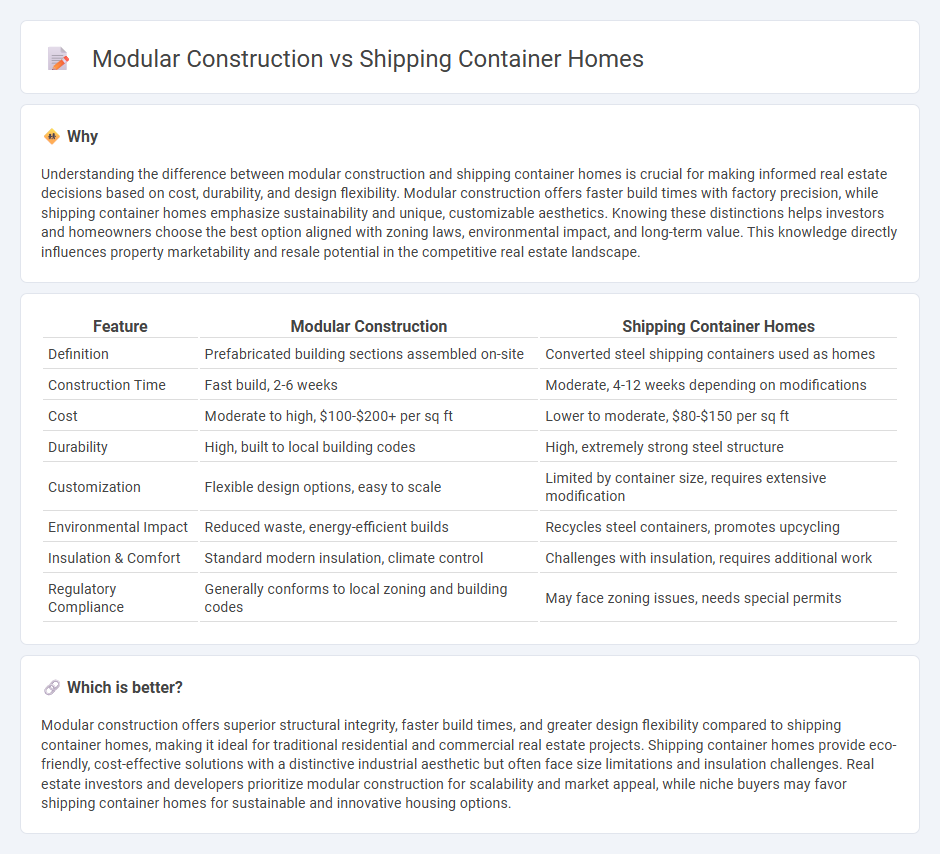
Modular construction and shipping container homes represent innovative approaches within the real estate industry, offering cost-effective and sustainable alternatives to traditional building methods. Modular construction involves factory-built sections assembled on-site, ensuring faster build times and high-quality control, while shipping container homes repurpose durable steel containers, emphasizing eco-friendly design and versatility. Explore the benefits and differences of these modern building solutions to find the perfect fit for your next property investment.
Why it is important
Understanding the difference between modular construction and shipping container homes is crucial for making informed real estate decisions based on cost, durability, and design flexibility. Modular construction offers faster build times with factory precision, while shipping container homes emphasize sustainability and unique, customizable aesthetics. Knowing these distinctions helps investors and homeowners choose the best option aligned with zoning laws, environmental impact, and long-term value. This knowledge directly influences property marketability and resale potential in the competitive real estate landscape.
Comparison Table
| Feature | Modular Construction | Shipping Container Homes |
|---|---|---|
| Definition | Prefabricated building sections assembled on-site | Converted steel shipping containers used as homes |
| Construction Time | Fast build, 2-6 weeks | Moderate, 4-12 weeks depending on modifications |
| Cost | Moderate to high, $100-$200+ per sq ft | Lower to moderate, $80-$150 per sq ft |
| Durability | High, built to local building codes | High, extremely strong steel structure |
| Customization | Flexible design options, easy to scale | Limited by container size, requires extensive modification |
| Environmental Impact | Reduced waste, energy-efficient builds | Recycles steel containers, promotes upcycling |
| Insulation & Comfort | Standard modern insulation, climate control | Challenges with insulation, requires additional work |
| Regulatory Compliance | Generally conforms to local zoning and building codes | May face zoning issues, needs special permits |
Which is better?
Modular construction offers superior structural integrity, faster build times, and greater design flexibility compared to shipping container homes, making it ideal for traditional residential and commercial real estate projects. Shipping container homes provide eco-friendly, cost-effective solutions with a distinctive industrial aesthetic but often face size limitations and insulation challenges. Real estate investors and developers prioritize modular construction for scalability and market appeal, while niche buyers may favor shipping container homes for sustainable and innovative housing options.
Connection
Modular construction and shipping container homes both utilize prefabricated building techniques, significantly reducing construction time and costs compared to traditional methods. Shipping container homes serve as a specific application of modular construction, where standardized steel containers are adapted into residential units with customizable layouts. These innovative approaches promote sustainability by minimizing material waste and enabling efficient, scalable housing solutions in the real estate market.
Key Terms
Building Codes
Shipping container homes often face challenges meeting traditional building codes due to their unconventional materials and structural design, requiring specific modifications to comply with local standards. Modular construction, built in controlled factory settings, typically adheres more easily to building codes because modules are designed and inspected for compliance before assembly onsite. Explore detailed comparisons of building code compliance for these innovative housing options to make an informed decision.
Sustainability
Shipping container homes offer a sustainable housing solution by repurposing steel containers, reducing construction waste, and minimizing the demand for traditional building materials. Modular construction enhances sustainability through factory-controlled processes that lower energy usage, improve material efficiency, and reduce on-site disruptions and waste. Explore the environmental benefits and practical applications of both methods to determine which aligns best with your sustainable building goals.
Cost Efficiency
Shipping container homes offer significant cost savings due to their affordable raw materials and reduced construction time, often costing 20-40% less than traditional modular homes. Modular construction, while typically more expensive upfront, benefits from standardized manufacturing processes that can lead to lower labor costs and faster project completion for larger or more complex designs. Explore detailed cost comparisons and long-term financial benefits to determine the best option for your housing needs.
Source and External Links
Shipping Container Homes - Pros, Cons & Costs - Rise - Discusses the pros and cons of shipping container homes, including prefabrication, ease of transport, and environmental benefits.
Shipping Container Home Design and Plans - Oasis Engineering - Offers custom design services for shipping container homes, providing plans that are safe, structurally sound, and compliant with local building codes.
Backcountry Containers: Modern & Functional Container Homes - Provides a range of standard and custom shipping container homes designed for durability and compliance with local regulations, with options for various sizes and locations.
 dowidth.com
dowidth.com